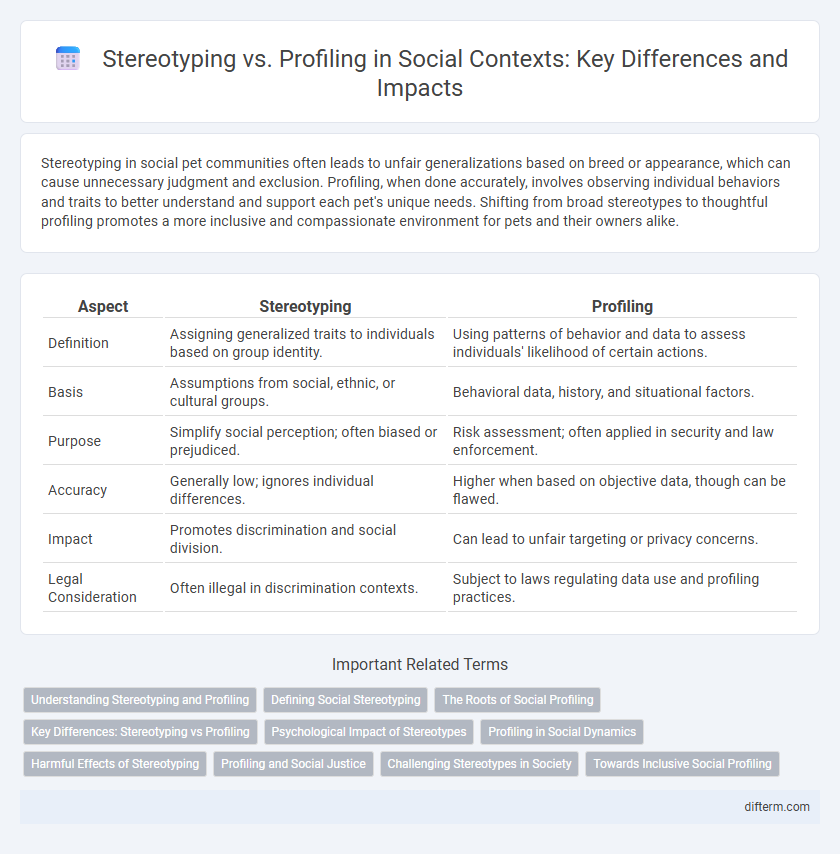Stereotyping in social pet communities often leads to unfair generalizations based on breed or appearance, which can cause unnecessary judgment and exclusion. Profiling, when done accurately, involves observing individual behaviors and traits to better understand and support each pet's unique needs. Shifting from broad stereotypes to thoughtful profiling promotes a more inclusive and compassionate environment for pets and their owners alike.
Table of Comparison
| Aspect | Stereotyping | Profiling |
|---|---|---|
| Definition | Assigning generalized traits to individuals based on group identity. | Using patterns of behavior and data to assess individuals' likelihood of certain actions. |
| Basis | Assumptions from social, ethnic, or cultural groups. | Behavioral data, history, and situational factors. |
| Purpose | Simplify social perception; often biased or prejudiced. | Risk assessment; often applied in security and law enforcement. |
| Accuracy | Generally low; ignores individual differences. | Higher when based on objective data, though can be flawed. |
| Impact | Promotes discrimination and social division. | Can lead to unfair targeting or privacy concerns. |
| Legal Consideration | Often illegal in discrimination contexts. | Subject to laws regulating data use and profiling practices. |
Understanding Stereotyping and Profiling
Stereotyping involves attributing generalized traits to individuals based on group identity, often leading to biased assumptions that overlook personal differences. Profiling focuses on analyzing specific behaviors or patterns, typically in security or law enforcement contexts, to identify individuals who may pose a risk, yet it can still perpetuate prejudice when based on overly broad characteristics. Differentiating between these concepts is crucial for fostering fair social interactions and minimizing discrimination rooted in unfounded judgments.
Defining Social Stereotyping
Social stereotyping involves assigning generalized traits or behaviors to individuals based on perceived group characteristics, often ignoring personal individuality and diversity. This cognitive shortcut simplifies complex social information but frequently leads to biased assumptions and unfair treatment. Understanding social stereotyping is crucial to addressing prejudice and promoting more inclusive interactions.
The Roots of Social Profiling
Social profiling originates from cognitive shortcuts formed by societal norms and personal experiences, leading individuals to categorize others based on perceived group traits. This process often stems from implicit biases ingrained through cultural narratives and media representations, reinforcing stereotypes without conscious awareness. Such deep-rooted mechanisms influence judgment and decision-making, shaping social interactions and institutional practices.
Key Differences: Stereotyping vs Profiling
Stereotyping involves generalized assumptions about a group based on oversimplified traits, often ignoring individual differences, whereas profiling uses specific criteria such as behavior patterns or demographic data to assess potential risks or characteristics. Stereotyping is mainly rooted in bias and prejudice, leading to unfair judgments, while profiling aims to be more data-driven, though it can also perpetuate biases if misapplied. Understanding these distinctions is crucial in social contexts to minimize discrimination and enhance fairness in decision-making processes.
Psychological Impact of Stereotypes
Stereotyping often leads to negative psychological effects such as reduced self-esteem, increased anxiety, and internalized prejudice, which can limit an individual's social and professional opportunities. Unlike profiling, which may involve behavioral assessment for security or law enforcement, stereotypes are generalized assumptions that cause emotional harm and reinforce social inequalities. Research shows that exposure to persistent stereotypes triggers stress responses and impairs cognitive functioning, deeply affecting mental health outcomes.
Profiling in Social Dynamics
Profiling in social dynamics involves categorizing individuals based on observed behaviors, roles, or group characteristics to predict actions or social interactions. Unlike stereotyping, which assigns fixed and often inaccurate traits to groups, profiling uses contextual information and patterns to inform understanding and decision-making within social environments. Effective profiling can enhance social cohesion and cooperation by tailoring responses to nuanced social signals and individual differences.
Harmful Effects of Stereotyping
Stereotyping perpetuates inaccurate generalizations that reinforce social biases and discrimination, limiting individuals' opportunities and self-expression. It undermines social cohesion by fostering mistrust and hostility between groups, leading to increased social fragmentation and conflict. These harmful effects contribute to systemic inequality and hinder efforts toward diversity and inclusion in various social settings.
Profiling and Social Justice
Profiling involves categorizing individuals based on perceived traits or behaviors, often leading to systemic biases and discrimination within social justice contexts. This practice undermines equitable treatment by reinforcing unjust stereotypes and perpetuating inequalities in legal and social systems. Addressing profiling is crucial for advancing social justice initiatives that promote fairness and protect marginalized communities from prejudiced practices.
Challenging Stereotypes in Society
Challenging stereotypes in society requires recognizing the distinct difference between stereotyping and profiling, where stereotypes are oversimplified and fixed perceptions about groups, while profiling involves making decisions based on specific attributes. Effective social interventions focus on education and exposure to diverse experiences, which help dismantle harmful generalizations and promote empathy. Promoting critical thinking and media literacy further reduces the reliance on stereotypes, fostering inclusive communities resilient to bias.
Towards Inclusive Social Profiling
Inclusive social profiling emphasizes understanding individuals beyond surface-level stereotypes by incorporating diverse cultural, social, and personal contexts. Moving away from biased generalizations, this approach leverages data-driven insights and empathetic engagement to foster equity and respect in social interactions. Prioritizing inclusivity in profiling processes helps dismantle prejudice and promotes a more just society.
stereotyping vs profiling Infographic

 difterm.com
difterm.com